Affiliate disclosure: This post may contain affiliate links. Please see our Privacy Policy.
Plantain salve is one of the best ways to start a home herbal first aid kit. Plantain is abundant, and this easy to make salve is good for all manner of minor burns, cuts, and stings.
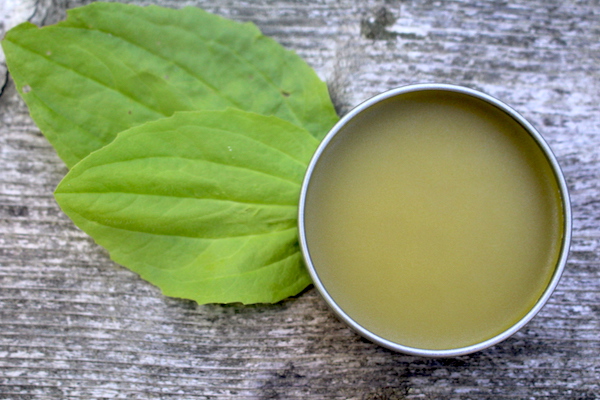
Sometimes we all need a bit of boo-boo medicine, whether you’re 5 or 50. Plantain salve is just that, the perfect medicine to treat all of life’s little cuts, scrapes, stings, and abrasions.
Herbalists know plantain as natures’ band-aid, and the large oval leaves are perfect for wrapping around minor injuries. It’s well known as a bee/wasp sting treatment, and a little plantain poultice works fast for relief when little else will. Both of these assume you’ve got fresh plantain on hand, which may or may not be the case.
Making plantain salve combines the healing benefits of common plantain with the soothing effects of oil and beeswax. It also preserves plantain in a convenient form right in your medicine cabinet or first aid kit.
Though plantain is incredibly common, it’s only available for harvest 4-5 months of the year here in Vermont. Short summers mean we need to preserve our medicine so it’s on hand when we need it. If you’re not familiar with plantain, read up on how to forage plantain for proper identification.
Out of season, dried plantain is available from Mountain Rose Herbs. If you’re just hoping to find a ready-made salve and skip the DIY portion, I’d suggest checking on Etsy for small-scale cottage industry producers since it’s not something that you’ll find in a store.
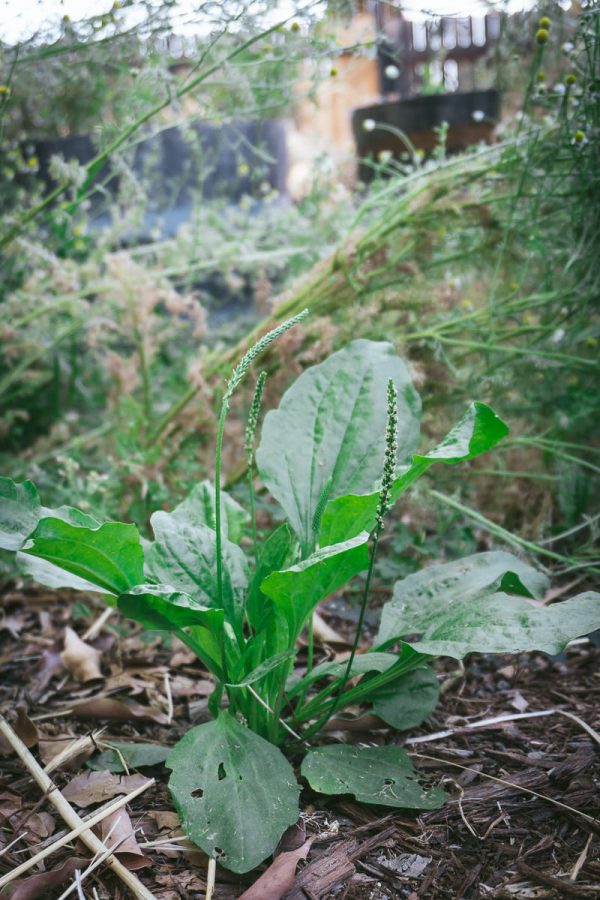
(Always consult your doctor or a clinical herbalist before trying any new herbal remedy, as there’s always the possibility of unintended consequences, allergic reaction, or interactions with other medication. If you’re harvesting wild plant material, make sure you’re 100% confident in your identification and consult multiple sources for your ID. The following is based on my research and experience, but I don’t claim to have any certifications that would qualify me to advise you on your health. Please do your own research and always verify with multiple reputable sources.)
Benefits of Plantain Salve
According to WebMD, the herb “plantain contains substances which might help decrease pain and swelling (inflammation)…. It might also be able to kill bacteria and fungi.”
While plantain is also used to decrease inflammation internally, a plantain salve will only be used topically. According to Gia Herbs, “Plantain has been used to support healthy levels of inflammation both internally as an extract and externally, as a topical agent. Topically, the leaves or extracts of the leaves are often used to soothe irritated skin.” This includes all manner of skin irritations and minor inflammatory conditions, from eczema to minor allergic reactions, as well as cuts and stings.
According to Kaiser Permanente Health System, “Plantain has long been considered by herbalists to be a useful remedy for cough, wounds, inflamed skin or dermatitis, and insect bites. Plantain is approved by the German Commission E as topical use for skin inflammations. The fresh leaves can be applied directly three or four times per day to minor injuries, dermatitis, and insect stings.”
Applying a homemade herbal salve is similar to applying the fresh plant material, and herbalists often employ this traditional preparation. Keep in mind though, there are no peer-reviewed scientific studies (at least that I can find) to back up this traditional use.
Plantain isn’t meant to treat anything beyond minor superficial injuries, and you should seek medical attention for puncture wounds, serious rashes, or large contusions.
Supplies & Equipment for Making Plantain Salve
The equipment you need is pretty basic. A simple double boiler, either a store-bought double boiler or hacked up in your kitchen (as I’m doing) will allow you to gently heat the oils.
The herbal material is infused into a neutral oil, and olive oil is a great all-purpose choice. Other oils like grapeseed and jojoba oil work well too and have other skin-nourishing benefits.
Beeswax thickens this salve, and you can weigh out pieces of wax from a large block if you wish. I really love using beeswax pellets for making slaves because it’s really easy to measure.
Either way, you’ll need a small kitchen scale. (Unless you happen to find beeswax in convenient 1 oz bars, like these.)
Finally, containers for the finished salve. I’m using 2-ounce salve tins which screw shut and make great gifts. You can also use any small jar with a tight-fitting lid, such as quarter pint mason jars.
How to Make Plantain Salve
The process for making plantain salve is more or less the same as making any herbal healing salve. It all starts with collecting fresh plant material (or finding a good source for dried plantain leaves).
Be sure to harvest from a clean area that’s not sprayed with herbicides or pesticides, and avoid places where dogs are routinely walked.
Our side yard is the perfect spot, rich in broadleaf plantain and completely free of contamination of any sort.
I start by packing a mason jar full of clean plantain leaves. (Note that other plantain varieties such as narrow-leaf plantain also work.)
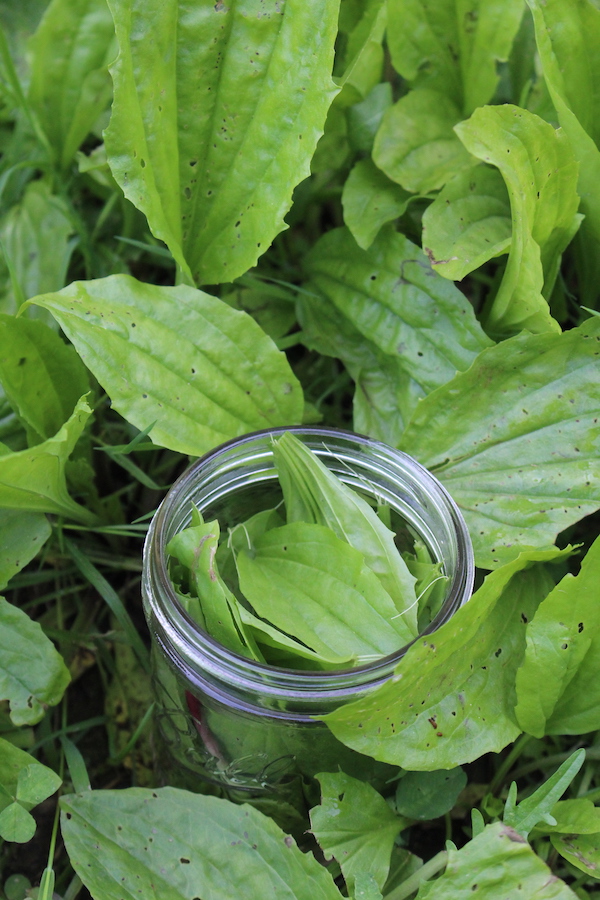
The next step is increasing surface area. A sharp knife or a pair of scissors will make quick work of the plantain leaves, chopping them into small pieces.
With more surface area, the medicinal constituents within the herbal material are better able to infuse into the oil.
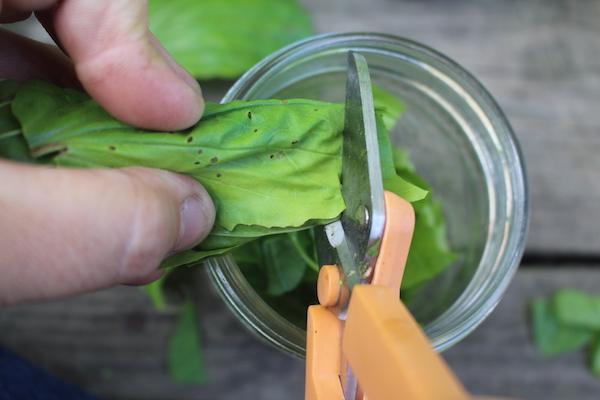
At this point, you can either dry the chopped plantain leaves, or proceed immediately to make a herbal salve with fresh leaves. The process is a bit different, depending on the variation you choose.
If you’re working with dried plant material, simply cover the dry leaves in neutral skin-safe oil (like olive oil or grapeseed), cap up the jar, and allow it to infuse out of direct sunlight for 4-6 weeks.
Fresh plant material has unique challenges. All the water in the leaves will cause the oil to go rancid if it’s allowed to slowly infuse over the course of several weeks. You need to speed things up a bit, and since bug bite season overlaps with plantain season, I’m choosing the rapid infusion route.
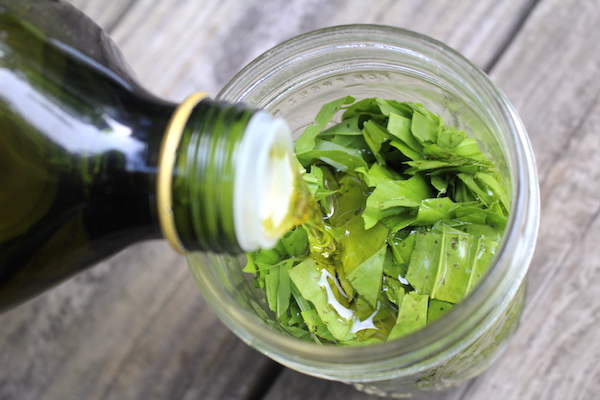
To make salve with fresh plantain leaves, start by covering the chopped leaves with oil.
Leave the jar open and place it in a double boiler with a bit of water. You’ll need a spacer at the bottom of either a saucepan or a crockpot, to keep the jar away from direct heat. I use either canning jar lids or an old cotton dish towel.
Place the jars on the spacer within the pot or crockpot and then add water.
Slowly warm the water to 110 to 120 degrees. Don’t allow the temperature to get too hot, you’re not deep-frying the herbs, you’re just trying to gently infuse them with a bit of warmth. Cooking the plant material means you’re cooking off the medicinal components.
Allow the plantain oil to infuse for 24 to 48 hours at a consistent 110 to 120 degrees. I do this by periodically turning the stove on very low, and then leaving it off but covered with a towel overnight.
For efficiency, you can infuse multiple oils at once if you’d like. Below I’m infusing arnica oil for massage, comfrey oil for comfrey salve, yarrow oil for wounds, and plantain oil for my homemade plantain salve.
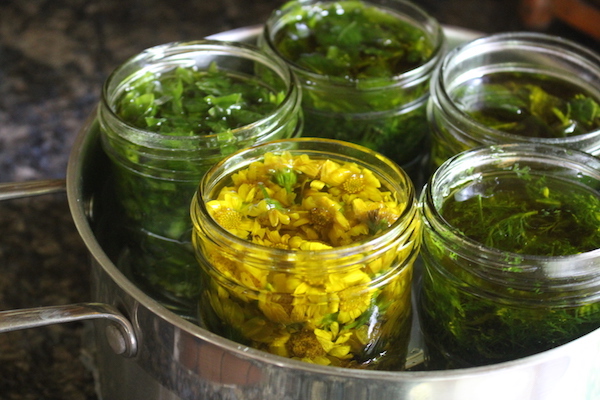
(For more specifics, I’d suggest this article on making herbal infused oils.)
Once you’ve infused plantain into a carrier oil, it’s time to make the finished salve. Filter out the plant material and measure out 1 cup (8 ounces) of infused oil.
Place that infused oil in a heat-safe bowl and gently warm it above simmering water (you’re creating a double boiler for a second time here). Add in 1 ounce of beeswax and continue to gently heat the oil until the wax has melted.
Once the wax is melted, stir to ensure it’s evenly distributed, and then pour the plantain salve into salve tins (or small mason jars).
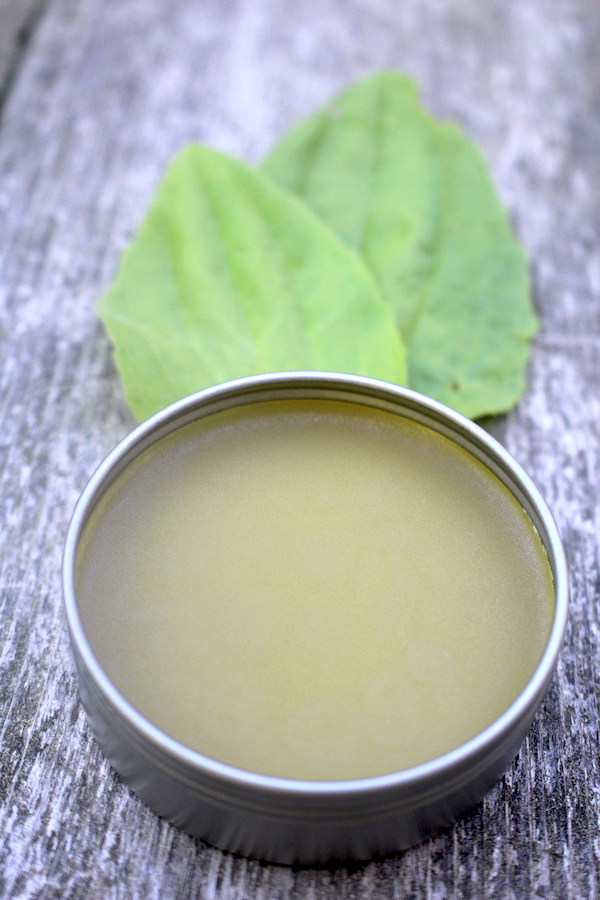
Homemade herbal salves are usually considered effective for about 1 year, as a general rule.
We make a small batch of 4-6 tins for life’s little boo-boos and that’s plenty to share with family and friends.
Even with two small children in the house, we only need 2-3 tins a year to handle all our minor cuts, scrapes, and stings. That’s even with living almost full time outdoors either in the garden or in the woods.
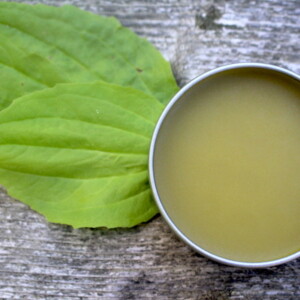
Plantain Salve
Equipment
Ingredients
- 1 1/2 to 2 cups fresh plantain herb
- 1 1/4 to 1 1/2 cups Olive oil or other neutral oil
- 1 ounce Bees Wax
Instructions
- Harvest fresh plantain from a clean, uncontaminated area. As with any wild plant, always be 100% positive on your identification before harvesting.
- Chop the plantain leaves and use them to fill a pint mason jar most the way to the top.
- Cover the fresh herb with a neutral oil, such as olive oil or grapeseed oil.
- Place the mason jar on a trivet in a double boiler or crockpot and add water to the pot.
- Gently heat the water until it’s 110 to 120 degrees and turn off the heat.
- Periodically turn on the heat to maintain this warm infusing environment for 24 to 48 hours. (Never leat the heat on overnight or for long periods, and be careful not to overheat and cook the plant material.)
- Once the fresh plantain has infused into the oil, strain out the plant material.
- Place the strained plantain infused oil into a heatproof bowl and then put that bowl above a pot of gently simmering water (again, creating a double boiler).
- Add the beeswax and gently heat the oil just until the beeswax melts.
- Stir to ensure the beeswax is evenly distributed and then pour into prepared salve tins (or small mason jars).
- Allow the salve to cool completely and set up before using (usually around 30 minutes).
Notes
More Homemade Herbal Remedies
Looking for more herbal goodness?
- Homemade Herbal Shampoo
- Echinacea Tincture
- Elderberry Syrup
- Herbal Immunity Tea for Winter Immune Support
Disclaimer on Homemade Herbal Remedies
I’ve been foraging wild medicines and treating my family with herbal remedies for the past 20 years, but I’m self-taught. Be aware that I am not a clinical herbalist, and this is based on my own research and personal experience using medicinal plants. I do not claim to have the experience that’d qualify me to advise you on your health, and I’m only providing this as a reference to encourage a broader interest in medicinal plants.
Please use this as a jumping-off point, but always do your own research and verify anything you read with multiple sources.
It’s always possible to have an adverse reaction to any medicinal herb, and plenty of people are allergic to even gentle herbs like chamomile. Always consult your doctor or a certified herbalist before trying any new medicinal plant. Often, they can have unintended reactions in combination with other herbs and supplements, and many herbs have side effects even when they are effective for their intended purpose.
If you are seriously interested in herbal medicine, I’d suggest investing in a course in herbal medicine, and I’d recommend any of the online courses put out by the Herbal Academy of New England. Specifically, the introduction to herbal medicine course and the family herbalist group of courses.
They also have a mushroom course, covering both medicinal and edible mushrooms, and a Botany and Wildcrafting Course. I’ve taken both and they’re informative, inspiring, and artfully presented.
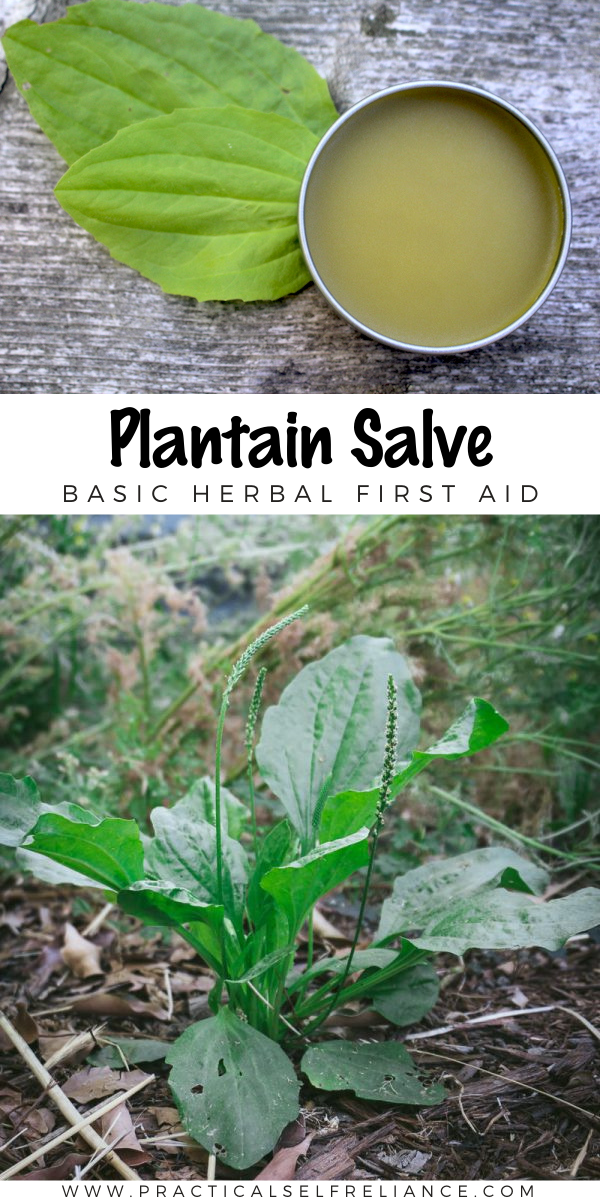
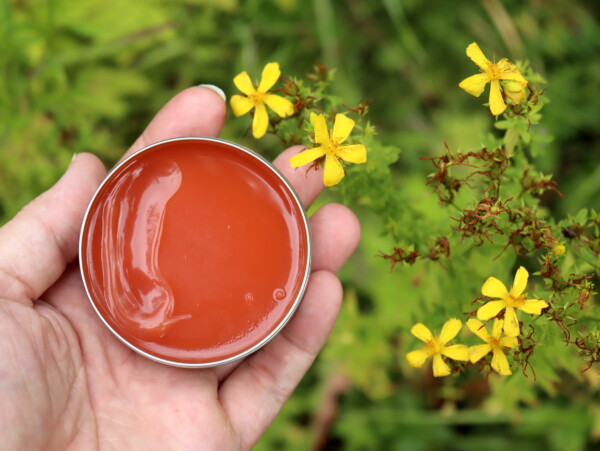
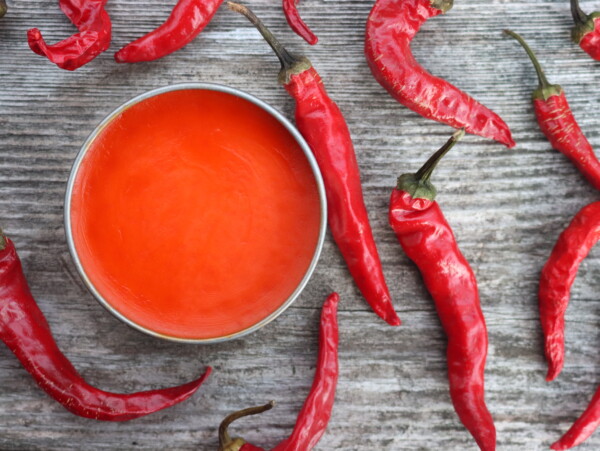
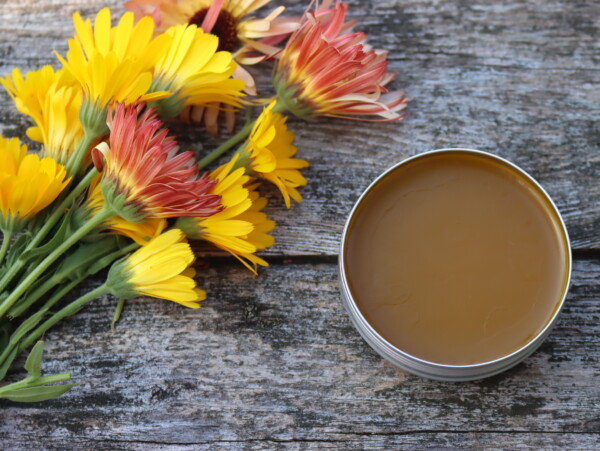
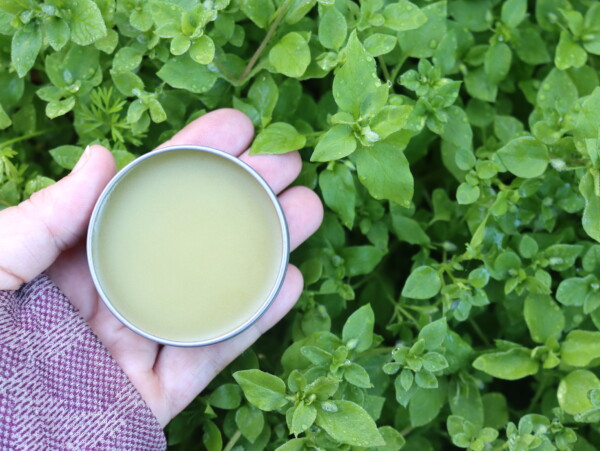
Have you tried this method using refined coconut oil? I wasn’t sure how the texture would be compared to the olive oil which remains in liquid form.
I haven’t, but you definitely could. It would come out firmer with coconut oil, but only slightly. You could also add just a fraction less bees wax. Either way, it should work just fine.
Will olive oil go rancid?
It actually has a much better shelf life when made into a salve.
I can’t wait to try this, I think I’ll use my instant pot on the yogurt setting to keep it at the right temperature! Thanks for all the information 🙂
You’re very welcome.
What other fresh herbs can you use the rapid infusion method on? Yarrow leaves? Red clover blossoms?
You can use this method for pretty much any fresh herb that you want to infuse.
I think I have a ton of this growing in my grass. I should harvest it.
Yes, you should.
Can I use soy wax instead of beeswax?
Soy wax should work but most soy comes from GMO sources so I try to avoid it. You may also need to adjust the ratio a little bit because the consistency may be a little different from beeswax.
I should definitely make this and have one hand.
Where can I buy a plantain plant or seeds. To be able to have some in my own yard or area
It looks like Strictly Medicinal Seeds has several different varieties to choose from. https://strictlymedicinalseeds.com/?s=plantain&post_type=product&title=1&excerpt=1&content=1&categories=1&attributes=1&tags=1&sku=1&ixwps=1
How do you know if the plantain comes in the oil? What is the effect if it does? It definitely smelled a bit like cooked greens when I drained the oil.
As long as you followed the directions for infusing the oil you can be sure that the plantain infused into the oil.
Thanks so much for this recipe! I use plantain while camping but would love to have it all year long. I have a bee allergy, any suggestion on what I could use to substitute the beeswax?
You could easily substitute both the olive oil and beeswax for coconut oil that is solid at room temperature. Heat your coconut oil until it melts, add your herbs and infuse as directed. After you’re finished infusing and straining the oil, the coconut oil will return to a solid once it cools back down to room temperature. You could also substitute the beeswax for a hard butter like cocoa butter but you may need to use a little bit more cocoa butter than beeswax to get the correct consistency.
Thank you for your recipe I had a block of beeswax so I shaved off the wax and put it in 1 ounce container and then melted it in I found that my salve didn’t really set it’s quite runny still. What do you think I did wrong? Or how can I fix it? I thought it would be kind of the consistency of a lip balm
You didn’t necessarily do anything wrong. I would just recommend remelting the salve and adding in more beeswax until you get the consistency that you desire.
What measurement do I use if using solar infusion?
The measurements are the same regardless of the infusion method.
Can I add a couple drops of essential oil (like lavender) in for the pleasant smell. or will that mess up the setting of the oil/wax?
Nope. That’s totally fine!
Thank you!
Can this be frozen to use at a later date?
Yes, freezing will extend the life of your salve.
Are you heating it to 110 Celsius or Fahrenheit?
Fahrenheit definitely! The idea is to get it warm but not cook the plant material.
I’ve used solvents to remove the oils from the plant material. They work really well at removing all the oil. Acetone is ok, but 100 med grade isopropyl alcohol works really well. Chop plant material fine, then let set in solvent. Strain infusion, then render the mixture till all that’s left is the pure oil from the plant. I do the rendering outside as the fumes can dissipate without fouling my indoor air. What’s left is pure plant oil.
You say render the strained plantain leaves and then render until all that’s left is the pure oil…How do you render it…The only thing I ever knew about rendering is rendering fat into lard…
Thank you in advance
I’ve been meaning to learn to how to make plantain salve for ages! Just picked my plantain and can’t wait to give it a whirl. Thanks!
I have used a gifted sous vide machine to maintain perfect temps for cooking and keeping things from being over heated
Nice! I had no idea they could be set that low.
my sister saw me reading this article and bought one on the sly.https://www.seriouseats.com/2016/01/first-thing-to-cook-with-sous-vide-immersion-circulator-essential-recipes.html
After using it I returned the favor. they do go on sale and have different models. We both got anovas fwithout wifi for under $80. Perfect meat prep as well as other things and the serious eats website has loads of info on it…..no connection!
Erik
ps like your diverse site
Awesome, thank you! I’ll look into them, I’ve never used one.
Urishiol in poison ivy and poison sumac is very difficult to break down. Only acetone will break it down but Jewel Weed sap will also break down urishiol. To get rid of the rash plantain is amazing for this. After you have gotten all the urishiol off your skin using jewel weed take plantain and crush it so you can get the juices freed and apply it to the rash and it will get rid of the itching pretty quickly and it will dramatically speed up the healing of the skin. Learned this through trial and error.
I have (thankfully) never had poison ivy. Kind of amazing given all the crazy places I crawl into foraging, but good to know for when it eventually happens!